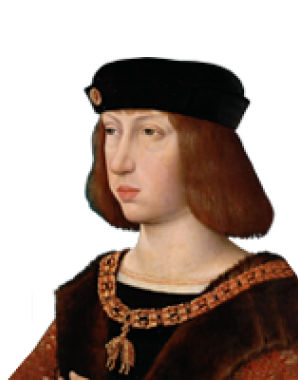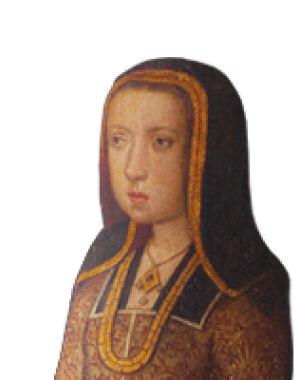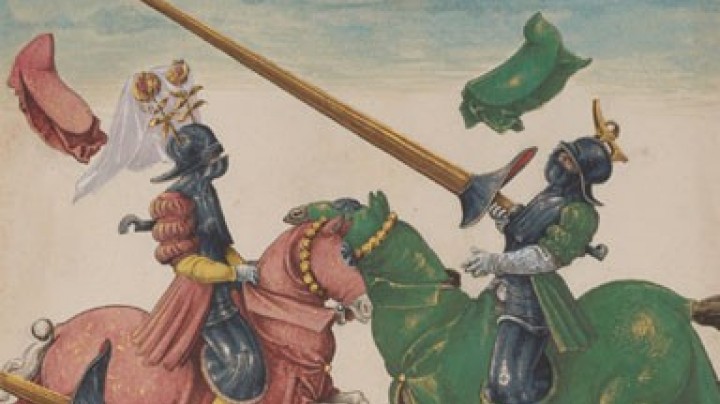Joan the Mad
Joan (Juana) was the third child of the ‘Catholic Kings’, Ferdinand of Aragon and Isabella of Castile, under whose rule the various territories of the Iberian peninsula were united for the first time, giving birth to Spain as we know it today.
Joan’s marriage to Philip I was to have far-reaching historical significance. In a spectacular double wedding celebrated in 1496 Joan and her brother John were married to Philip and Margaret, the children of the Habsburg emperor Maximilian I.
The consequence of this dynastic union only became evident after Joan’s brother, Crown Prince John, his infant son and Joan’s elder sister Isabella, who was married to the king of Portugal, all died immediately after one another, leaving Joan sole heiress to the united crowns of Castile, Aragon, Leon and Granada from 1500.
However, Joan’s position became increasingly difficult. Philip regarded himself as the sole representative of his wife, whom he gradually excluded from political affairs. He also attempted to alienate her from her parents. After the death of Joan’s mother Isabella in 1504 there was open confrontation between her husband and her father Ferdinand regarding the claim to rulership of Castile. Joan became a pawn in the conflict between the rival parties.
From the age of 22 she began to exhibit signs of mental illness, a condition that would today probably be diagnosed as schizophrenia. However, the actual degree of her mental disorder is difficult to assess, as the accounts of her behaviour were to some extent distorted by the interest of her husband and father in undermining her authority. Philip succeeded in assuming the position of guardian to his wife as ruler of Castile. Her father Ferdinand also made much of Joan’s unsuitability as a ruler in his rivalry with his son-in-law.
Joan’s marriage to Philip, who evidently lived up to his epithet of the Fair, was initially marked by the couple’s great devotion to each other. Joan’s sensuality is emphasized by her biographers, but her passion for her husband began to take on pathological features. The couple were often separated, as Philip needed to spend long periods in the Netherlands while Joan had to show her presence in Castile. Joan pressed for them to live together permanently, a project that became her sole purpose in life. She suffered from her separation from Philip, who evidently did not take his vows of conjugal fidelity very seriously. Dramatic scenes of jealousy ensued, with Joan sometimes physically attacking her real or supposed rivals.
Another of her traits was a pronounced melancholy, or as we would probably say today a tendency to depression, which often left her sitting motionless, staring straight ahead, for days on end. She refused all communication with those around her and developed an obsessive compulsion to wash her hair several times a day.
After the sudden death of Philip in 1506 her mental health deteriorated. Her love for her husband developed into a mania. She would not allow his mortal remains out of her sight, having his corpse taken out of its coffin and put into a bed in her room, to which no one was admitted.
In 1509 on her father’s orders, Joan was taken to the convent of Tordesillas, where she was looked after by nuns of the Poor Clares until her death. She lived there in complete seclusion. However, her existence was exploited politically when the occasion demanded, for example by her son Charles, who used Joan in his efforts to have his hereditary claims on Castile recognized. Once this had been accomplished, his interest in the fate of his mother waned markedly, a circumstance which Joan often lamented. She last appeared in public in 1520, when the leaders of the revolt of the Comunidades against Charles’s rule attempted to instrumentalize the forgotten queen for their own purposes.
Her mental state deteriorated over the years. She refused to practise any kind of personal hygiene and was neglected and abused by those around her. Alternating between total apathy and episodes of aggression, she now had only rare moments of lucidity. Joan spent forty-six years imprisoned in the convent before her death at the age of seventy-five in 1555.
She was buried beside her parents and husband in the Capilla Real of the cathedral of Granada.















